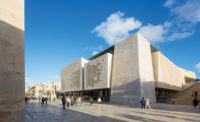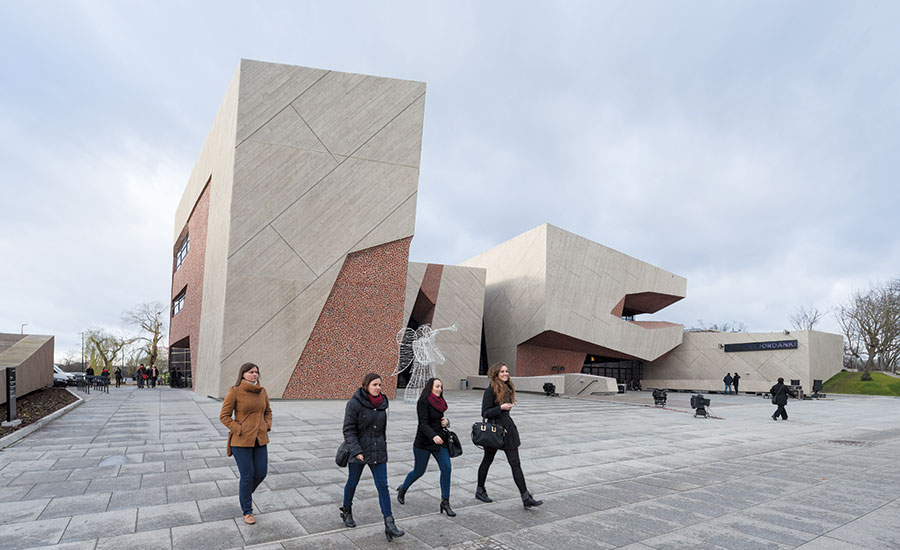CKK Jordanki
Finely Tuned: Fernando Menis’s idiosyncratic forms and rugged surfaces belie a polished concert-hall experience in northern Poland.

Red “picado” brickwork in the facade recurs in the chamber hall and the main concert hall.
Photo © Iwan Baan

The hall can be tuned by lowering five large white concrete shells, known as cupolas, to vary the reverberation times between 1.85 and 1.2 seconds.
Photo © Iwan Baan

The halls share foyers, where “picado” stonework peels away from the poured-in-place concrete structure, whose thermal mass regulates temperature.
Photo © Iwan Baan

Stairs descending to the basement level from the street and park form a top-lit route through the building.
Photo © Iwan Baan

Photo © Iwan Baan

Photo © Iwan Baan

Photo © Iwan Baan

Photo © Iwan Baan

Photo © Iwan Baan

Photo © Iwan Baan

Photo © Iwan Baan

Photo © Iwan Baan

Photo © Iwan Baan

Photo © Iwan Baan

Photo © Iwan Baan

Image courtesy Fernando Menis


















Architects & Firms
Poland
The CKK Jordanki concert hall emerges like an outcrop of weathered rock from an urban park in Toruń, in northern Poland. Its Spanish architect, Fernando Menis, has yoked such imagery to local architectural references and technical ingenuity to establish a strong character for the building while deferring to its sensitive setting on the edge of the medieval Old Town. While the form is intended to suggest a “natural object” in the landscape, facades are accented with the red brick of the city’s celebrated gothic architecture, which finds more dramatic expression here as an innovative lining to two cavernous—and acoustically refined—auditoria.
Half buried to minimize intrusion on the skyline, the building comprises four visually separate concrete forms linked above ground by glazed enclosures and below grade by a shared basement. Approaching from the Old Town, the first volume contains offices and a café, while the second and third blocks house the chamber music and main concert halls. The fourth, containing technical equipment, is set into an embankment.
Inclined walls and cranked rooflines are crisply articulated in white board-formed concrete scored with angled control joints. Menis’s treatment of these massive, almost blank forms begins a tectonic game that is further developed inside, offering multiple readings and subverting a visitor’s understanding of the building’s construction. On the face of each block, patches of béton brut are neatly excised to reveal a lumpy subcutaneous layer of broken red brick. This was created using Menis’s own “picado” technique, in which masonry fragments are cast in concrete and the surface then chiseled with pneumatic drills to give a flush but undulating texture. The abraded aggregate is immediately familiar, resembling the predominant material of Toruń’s gothic Old Town but made strange by its contemporary reinterpretation. The brickwork is a “tribute to the history of Toruń,” says Menis, “but demonstrates that it is possible to be innovative while respecting the past.”
Rugged picado lines deep angular openings in the facade. A cut into the base of the largest block marks the main entrance, while another creates a balcony in the overhang above. Beyond glazed entrance screens, the irregular planes of picado continue inside, forming foyers with crazily canted walls and emphatic bends and bulges in the ceiling. The red brick of the exterior, speckled with purples and burnt blacks, is here replaced by dark stone, reversing the chromatic balance. This porous volcanic tufa, characteristic of Menis’s home, Tenerife, Spain, in the Canary Islands, provides acoustic absorption in noisy public areas.


















